Arcitura Education S90.20 Exam Questions
- Topic 1: Fundamental SOA, Services & Microservices: The Arcitura Education Certified SOA Security Specialist exam explores contemporary service-oriented computing, emphasizing microservices, modern services, and SOA.
- Topic 2: Microservice Technology Concepts: This topic of the SOA Security Lab exam covers models and concepts vital for establishing secure and effective service implementation mediums.
- Topic 3: Fundamental Security for Services, Microservices & SOA: In this topic, SOA developers and security architects cover security-related patterns and technologies for establishing robust security controls and architectures.
- Topic 4: Advanced Security for Services, Microservices & SOA: Technical security sub-topics are covered here. The topic of the Arcitura Education S90.20 exam focuses on design, infrastructure, microservices, API gateways, and modern service technologies.
- Topic 5: Security Lab for Services, Microservices & SOA: By covering this topic, SOA developers and security architects learn how to assess case study backgrounds and carry out a series of exercises to solve different inter-related problems.
Free Arcitura Education S90.20 Exam Actual Questions
Note: Premium Questions for S90.20 were last updated On Apr. 21, 2025 (see below)
Service Consumer A sends a request to Service A (1). Service A replies with an acknowledgement message (2) and then processes the request and sends a request message to Service B (3). This message contains confidential financial data. Service B sends three different request messages together with its security credentials to Services C, D, and E (4, 5, 6). Upon successful authentication, Services C, D, and E store the data from the message in separate databases (7, 8, 9) Services B, C, D, and E belong to Service Inventory A, which further belongs to Organization B .Service Consumer A and Service A belong to Organization A .The service contracts of Services A and B both comply with the same XML schema. However, each organization employs different security technologies for their service architectures. To protect the confidential financial data sent by Service A to Service B, each organization decides to independently apply the Data Confidentiality and the Data Origin Authentication patterns to establish message-layer security for external message exchanges. However, when an encrypted and digitally signed test message is sent by Service A to Service B, Service B was unable to decrypt the message. Which of the following statements describes a solution that solves this problem?
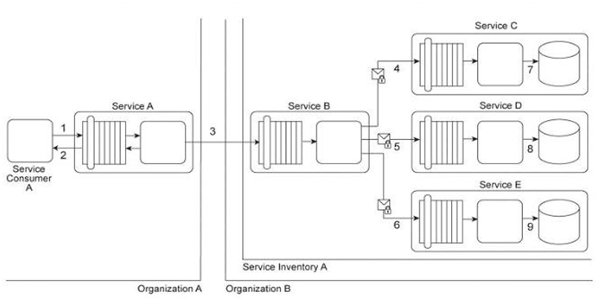
Service A is a publically accessible service that provides free multimedia retrieval capabilities to a range of service consumers. To carry out this functionality, Service A is first invoked by Service Consumer A (1). Based on the nature of the request message received from Service Consumer A, Service A either invokes Service B or Service C .When Service B is invoked by Service A (2A) it retrieves data from publicly available sources (not shown) and responds with the requested data (3A). When Service C is invoked by Service A (2B) it retrieves data from proprietary sources within the IT enterprise (not shown) and responds with the requested data (3B). After receiving a response from Service B or Service C, Service A sends the retrieved data to Service Consumer A (4). Service B does not require service consumers to be authenticated, but Service C does require authentication of service consumers. The service contract for Service A therefore uses WS-Policy alternative policies in order to express the two different authentication requirements to Service Consumer A .When Service Consumer A sends a request message (1), Service A determines whether the request requires the involvement of Service C and then checks to ensure that the necessary security credentials were received as part of the message. If the credentials provided by Service Consumer A are verified. Service A creates a signed SAML assertion and sends it with the request message to Service C (2B) This authentication information is protected by public key encryption However, responses to Service Consumer A's request message (3B, 4) are not encrypted for performance reasons. Recently, the usage of Service C has noticeably declined. An investigation has revealed response messages issued by Service C (3B) have been repeatedly intercepted and accessed by unauthorized and malicious intermediaries. As a result, Service Consumer A has lost confidence in the use of Service A for the retrieval of proprietary data because it is being viewed as a security risk. This is especially troubling, because the owner of Service A had planned to start charging a fee for Service A's ability to provide proprietary data via the use of Service C .How can this service composition architecture be changed to address the security problem with minimal impact on runtime performance?
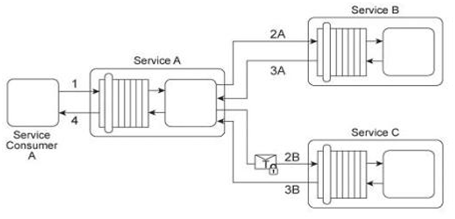
Service A provides a customized report generating capability. Due to infrastructure limitations, the number of service consumers permitted to access Service A concurrently is strictly controlled. Service A validates request messages based on the supplied credentials (1). If the authentication of the request message is successful, Service A sends a message to Service B (2) to retrieve the required data from Database A (3). Service A stores the response from Service B (4) in memory and then issues a request message to Service C (5). Service C retrieves a different set of data from Database A (6) and sends the result back to Service A (7). Service A consolidates the data received from Services B and C and sends the generated report in the response message to the service consumer (8). It has been discovered that attackers have been gaining access to confidential data exchanged between Service A and Service B, and between Service A and its service consumers. What changes can be made to this service composition architecture in order to counter this threat?
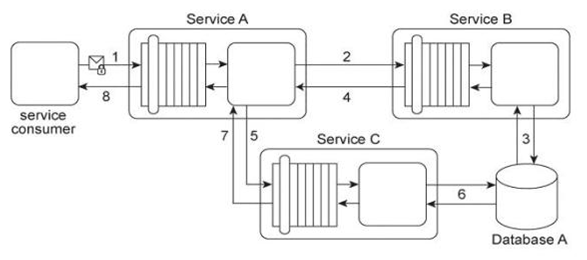
Service A provides a data access capability that can be used by a variety of service consumers. The database records accessed by Service A are classified as either private or public. There are two types of service consumers that use Service A:
Service consumers with public access permissions (allowed to access only public data records) and service consumers with private access permissions (allowed to access all data records). For performance reasons the Service A architecture uses a single database, named Database A .Each record in Database A is classified as either private or public. After Service A is invoked by a service consumer (1), it authenticates the request message using an identity store and retrieves the corresponding authorization (2, 3). Once authorized, the service consumer's request is submitted to Database A (4), which then returns the requested data (5) If the service consumer has private access permissions, all of the returned data is included in Service A's response message (6). If the service consumer has public access permissions, then Service A first filters the data in order to remove all unauthorized private data records, before sending to the response message to the service consumer (6). An investigation recently detected that private data has been leaked to unauthorized service consumers. An audit of the Service A architecture revealed that Service A's filtering logic is flawed, resulting in situations where private data was accidentally shared with service consumers that only have public access permissions. Further, it was discovered that attackers have been monitoring response messages sent by Service A in order to capture private data. It is subsequently decided to split Database A into two databases:
one containing only private data (the Private Database) and the other containing only public data (the Public Database). What additional changes are necessary to address these security problems?
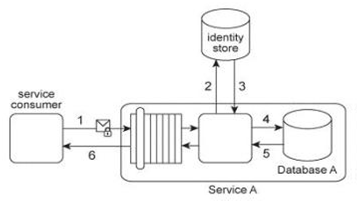
Service Consumer A submits a request message with security credentials to Service A (1). The identity store that Service A needs to use in order to authenticate the security credentials can only be accessed via a legacy system that resides in a different service inventory. Therefore, to authenticate Service Consumer A, Service A must first forward the security credentials to the legacy system (2). The legacy system then returns the requested identity to Service A (3). Service A authenticates Service Consumer A against the identity received from the legacy system. If the authentication is successful, Service A retrieves the requested data from Database A (4), and returns the data in a response message sent back to Service Consumer A (5). Service A belongs to Service Inventory A which further belongs to Security Domain A and the legacy system belongs to Service Inventory B which further belongs to Security Domain B .(The legacy system is encapsulated by other services within Service Inventory B, which are not shown in the diagram.) These two security domains trust each other. Communication between Service A and the legacy system is kept confidential using transport-layer security. No intermediary service agents currently exist between the two service inventories. However, it has been announced that due to the introduction of new systems, some intermediary service agents may be implemented in the near future. Additionally, the legacy system has been scheduled for retirement and will be replaced by a new identity management system that will provide a new identity store. Because the new identity store will need to serve many different systems, there are concerns that it could become a performance bottleneck. As a result, services (including Service A and other services in Security Domains A and B) will not be allowed to directly access the new identity store. Which of the following statements describes a solution that can accommodate the requirements of the new identity store, the authentication requirements of Service A, and can further ensure that message exchanges between Security Domains A and B remain confidential after intermediary service agents are introduced?
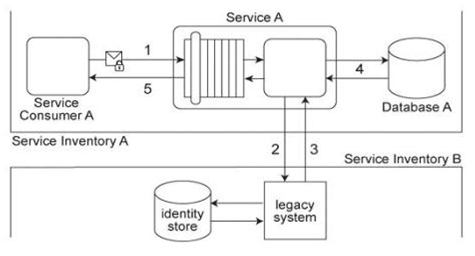
- Select Question Types you want
- Set your Desired Pass Percentage
- Allocate Time (Hours : Minutes)
- Create Multiple Practice tests with Limited Questions
- Customer Support
Fanny
11 days agoRodolfo
26 days agoDelisa
27 days agoKara
1 months agoIlene
2 months agoGlennis
2 months agoJacki
2 months agoAntonio
3 months agoMozell
3 months agoLuis
3 months agoTrinidad
3 months agoRebbecca
4 months agoIola
4 months agoGladys
4 months agoAllene
4 months agoStefany
5 months agoTiffiny
5 months agoDianne
5 months agoNgoc
5 months agoCarmelina
5 months agoAltha
6 months agoRozella
6 months agoNan
6 months agoKeneth
6 months agoKasandra
6 months agoKris
7 months agoDorethea
7 months agoAlethea
7 months agoClemencia
7 months agoStephen
7 months agoMelodie
8 months agoLenna
10 months ago